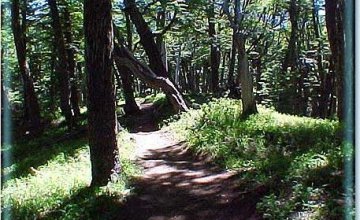Feeling very enthusiastic about the lush vegetation in San Carlos de Bariloche, we visited two well-known plant nurseries to see if we could take home one local specimen.
Mischa and Angelika
We were welcomed by Mischa, the owner of the place, who invited us to tour around the charming nooks of the huge piece of land where he has produced a wide variety of plants for the last 25 years. We followed him along the trails amidst green hues and colorful flowers and we identified species, origins, sizes and flowering periods.
Born in Bariloche, he told us about his adventures on a Jeep Willys with a hood in the company of his father around the local dirt roads, during which he learned how to make out species and their life cycles.
Visit to the Forest Nurseries
When he bought the land, there were some cypresses in the plot. Later on, he started to plant other species, waiting for their growth and changing their location as many times as necessary. This is how he managed the present landscape with the green shades of pañiles, maitenes, lengas, golden cedars, small-leaved lime or radales, to name a few. They provide protection to one another according to their need for humidity, shade and light.
“Every morning, I go out into the garden to watch the plants just like people watch the growth of their own children and feel proud to see them healthy, strong and integrated to the world of their peers”, Mischa told us while we watched which plants grow in front of which and how they are pruned.
We asked for details about the native species: the mountain range cypress, different kinds of Nothofagus and so on. We also saw some exotic species, such as tulip trees from the USA, European pines, Siberian lime and the alpenrose from the Himalayas.
The latter managed to become adapted and may show slower or smaller growth processes, as their cycles change due to the fact that they came to life in the other hemisphere. However, their beauty is so great that it is worth waiting.
When we talked about the volcanic ash rain in the area, we learned that there was some kind of fear at first. As this is a natural process, it was accepted by everyone, including the soil, that incorporated its minerals and produced a renovated very green grass in return.
Patagonian Woodlands
We got in touch with Guillermo Doll and headed for his venue, located in the area known as Las Chacras (the farms), in the outskirts of Bariloche, in order to understand the organization of a forest plant nursery.
Within a spacious and silent lot stroked by a soft breeze, we were surprised by a notorious order in each of the sectors. Thus, we observed the various lines of plants in the soil, seed beds and fruit trees with a strict irrigation system according to their own particular needs.
We moved onto the greenhouse to see the first stage of the sowing of those species that are later moved outside, whether to seedbeds, flowerpots or the soil.
After the visit to both plant nurseries, we were left under the impression of how important it is to understand the language of each species and their excellent co-existence standards. According to Mischa, we just have to wait for plants, to see how they behave and to find the proper place for them, just like what happens with human beings.
As we flew back home, we took some plants with their bare roots, an ideal packing method so that they do not suffer during the journey. We would show them off in our garden with the same exuberance they originally had.
Vivero Mischa
Address: 6328, Los Buhos Street
Te: 54 0294 -4442009 and cell phone 54 294 15 4 531718
E-mail: mischabariloche@arnet.com.ar
Vivero Forestal Bosques Patagónicos
Address: 7890, Con Con Street - Las Chacras - S C Bariloche
Te: 54 0294 4405872 celular 54 294 15 4419727
E-mail: gdoll@bariloche.com.ar
Mónica Pons
Eduardo Epifanio













































